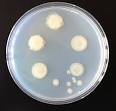Bacteria become resistant due to the use of antibiotics and the exchange of resistance genes between bacteria.
“Because of gene exchange, bacteria can develop resistance even if they are not exposed to antibiotics. Especially among notorious hospital pathogens, such as Escherichia coli and Klebsiella pneumoniae, the resistance genes are usually a part of mobile genetic elements that readily transfer from one bacterium to another,” says University of Jyväskylä's Academy Research Fellow Matti Jalasvuori.
But gene transfer goes both ways and that means it can also be turned against bacteria. The Jane and Aatos Erkko foundation awarded Jalasvuori’s research group 255,000 euros because they have developed modified bacteria that disseminate a resistance-gene destroying CRISPR-element instead of resistance genes. In the bacterial cell, this element recognizes different resistance genes and degrade them. Elements can be transferred intogut flora within harmless probiotic bacteria.

Such transfer of the element into resistant bacterium makes it again susceptible to antibiotics, and that means a cure for extended-spectrum β-lactamase (ESBL) carriage.
“Because of gene exchange, bacteria can develop resistance even if they are not exposed to antibiotics. Especially among notorious hospital pathogens, such as Escherichia coli and Klebsiella pneumoniae, the resistance genes are usually a part of mobile genetic elements that readily transfer from one bacterium to another,” says University of Jyväskylä's Academy Research Fellow Matti Jalasvuori.
Citation: Ruotsalainen, Penttilä, Mattila ja Jalasvuori, 'Midbiotics: conjugative plasmids for genetic engineering of natural gut flora', Gut Microbes, 05/2019, DOI: 10.1080/19490976.2019.1591136





Comments